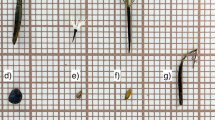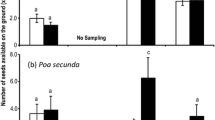Abstract
At our Costa Rican field site, seeds defecated by frugivorous birds usually do not remain where they have been deposited. Many species of ants are attracted to frugivore defecations and remove seeds and/or pulp. Pheidole species selectively remove seeds, fungus-growing species (tribe Attini) remove both pulp and seeds. Seeds of many Melastomataceae have an appendage, which we hypothesized is an elaiosome. Indeed, preference trials demonstrated that two species of Pheidole selected seeds with the appendage over seeds of the same species in which the appendage had been removed. However, we found that these ants did not take the appendage when it was offered by itself. We conclude that the appendage is not an elaiosome. In further trials, different ant species preferentially selected different seed species. These ants consumed some seeds and deposited others unharmed in refuse piles. We conclude that because the composition of leaf-litter ant communities is highly variable between neighboring square meter plots, and the probability of seed predation depends upon the species of ant, the over-all effect of ants on seed shadows and seed banks is spatially unpredictable.
Access this chapter
Tax calculation will be finalised at checkout
Purchases are for personal use only
Preview
Unable to display preview. Download preview PDF.
Similar content being viewed by others
References
Andersen, A. N. 1982. Seed removal by ants in the mallee of northwestern Victoria. In: Buckley, R. C. (ed.), Ant-plant interactions in Australia, pp. 31–43. Junk, The Hague.
Ashton, D. H. 1979. Seed harvesting by ants in forests of Eucalyptus regnans F. Muell. in central Victoria. Aust. J. Ecol. 4: 265–277.
Beattie, A. J. 1983. Distribution of ant-dispersed plants. Sonderb. Naturwiss. Ver. Hamb. 7: 249–270.
Beattie, A. J. 1985. The evolutionary ecology of ant-plant mutualisms. Cambridge University Press, Cambridge, UK.
Beattie, A. J. & Culver, D. C. 1982. Inhumation: how ants and other invertebrates help seeds. Nature 297: 627.
Beattie, A. J. & Lyons, N. 1975. Seed dispersal in Viola (Vi- olaceae): Adaptations and strategies. Amer. J. Bot. 62: 714–722.
Berg, R. Y. 1966. Seed dispersal of Dendromecon: its ecologic, evolutionary, and taxonomic significance. Amer. J. Bot. 53: 61–73.
Berg, R. Y. 1975. Myrmecochorous plants in Australia and their dispersal by ants. Aust. J. Bot. 23: 475–508.
Bond, W. J. & Breytenbach, G. J. 1985. Ants, rodents and seed predation in Proteaceae. S. Afr. J. Zool. 20: 150–154.
Bond, W. J. & Slingsby, P. 1984. Collapse of an ant-plant mutualism: The argentine ant (Iridomyrmex humilis) and myrmecochorous Proteaceae. Ecology 65: 1031–1037.
Brown J. H., Davidson, D. W. & Reichman, 0. J. 1979. An experimental study of competition between seed-eating desert rodents and ants. Amer. Zool. 19: 1129–1143.
Buckley, R. C. 1982. Ant-plant interactions: a world review. In: Buckley, R. C. (ed.), Ant-plant interactions in Australia,pp. 111–162. Junk, The Hague.
Bullock, S. H. 1974. Seed dispersal of Dendromecon by the seed predator Pogonomyrmex. Madrono 21: 378–379.
Byrne, M. M. 1991. Ecology and coexistence mechanisms of tropical twig-dwelling ants. M.S. Thesis, University of Florida.
Chapman, C. A. 1989. Primate seed dispersal: The fate of dispersed seeds. Biotropica 21(22): 148–154.
Clifford, H. T. & Monteith, G. B. 1989. A three phase seed dispersal mechanism in Australian Quinine bush. Biotropica 21: 284–286.
Culver, D. C. & Beattie, A. J. 1978. Myrmecochory in Viola: dynamics of seed-ant interactions in some West Virginia species. J. Ecol. 66: 53–72.
Davidson, D. W. 1977. Foraging ecology and community organization in desert seed-eating ants. Ecology 58: 725–737.
Davidson, D. W. & Morton, S. R. 1981. Myrmecochory in some plants (F. chenopodiaceae) of the Australian arid zone. Oecologia 50: 357–366.
Denslow, J. S. & Gomez-Diaz, A. E. 1990. Seed rain to treefall gaps in a Neotropical rain forest. J. Can. For. Res. 20: 642–648.
Drake, W. E. 1981. Ant-seed interaction in dry sclerophyl forest on North Stradbroke Island, Queensland. Aust. J. Bot. 29: 293–309.
Garwood, N. C. 1989. Tropical soil seed banks: a review. In: Leck, M. A., Parker, V. T. & Simpson, R. L. (eds), Ecology of soil seed banks, pp. 149–209. Academic Press, Inc. New York.
Gates, B. N. 1943. Carunculate seed dissemination by ants. Rhodora 45: 438–445.
González-Espinosa, M. & Quintana-Ascencio, P. F. 1986. Seed predation and dispersal in a dominant desert plant: Opuntia, ants, birds, and mammals. In: Estrada, A. & Fleming, T. H. (eds), Frugivory and seed dispersal, pp. 273–284. Junk, The Hague.
Hallwachs, W. 1986. Agoutis (Dasyprocta punctatá), the inheritors of guapinol (Hymenaea courbaril: Leguminosae). In: Estrada, A. & Fleming, T. H. (eds), Frugivory and seed dispersal, pp. 285–304. Junk, The Hague.
Hansen, S. R. 1978. Resource utilization and coexistence of three species of Pogonomyrmex ants in an Upper Sonoran grassland. Oecologia 35: 109–117.
Heithaus, E. R. 1986. Seed dispersal mutualism and the population density of Asarum canadense, an ant-dispersed plant. In: Estrada, A. & Fleming, T. H. (eds), Frugivory and seed dispersal, pp. 199–210. Junk, The Hague.
Herrera, C.M. 1986. Vertebrate-dispersed plants: why they don’t behave the way they should. In: Estrada, A. & Fleming,T. H. (eds), Frugivory and seed dispersal, pp. 5–20. Junk, The Hague.
Hölldobler, B. 1976. Recruitment behavior, home range creation and territoriality in harvester ants, Pogonomyrmex. Behav. Ecol. Sociobiol. 1(4): 405–423.
Hölldobler, B. & Wilson, E. O.1990. The ants. Belknap Press, Cambridge, MA.
Horvitz, C. C. & Beattie, A. J. 1980. Ant dispersal of Calathea (Marantaceae) by carnivorous Ponerines (Formicidae) in a tropical rain forest. Amer. J. Bot. 67: 321–326.
Horvitz, C. C. & Schemske, D. W. 1986. Seed dispersal of a neotropical myrmecochore: variation in removal rates and dispersal distances. Biotropica 18: 319–323.
Howe, H. H. 1986. Seed dispersal by fruit-eating birds and mammals. In: Murray, D. R. (ed.), Seed dispersal, pp. 123–190.Academic Press, Sydney, Australia.
Howe, H. H. 1989. Scatter- and clump-dispersal and seedling demography: hypothesis and implications. Oecologia 79: 417–426.
Janzen, D. H. 1982. Removal of seeds from horse dung by tropical rodents: influence of habitat and amount of dung. Ecology 63: 1887–1900.
Karasov, W. H. & Levey, D. J. 1990. Digestive system tradeoffs and adaptations of frugivorous passerine birds. Physiol.Zool. 63: 1248–1270.
Kjellsson, G. 1985. Seed fate in a population of Carex pilulifera L. I. Seed dispersal and ant-seed mutualism. Oecologia 67: 416–423.
Levey, D. J. & Byrne, M. M. 1990. Leaf-litter ‘squirrels’: Post-dispersal seed predation and scattering by tropical ants. Bull. Ecol. Soc. Am. 71: 229 (abstract).
Levey, D. J. & Karasov, W. H. 1989. Digestive responses of temperate birds switched to fruit or insect diets. Auk 106: 675–686.
Louda, S. M. 1989. Differential predation pressure: a general mechanism for structuring plant communities along complex environmental gradients? Trends Ecol. Evol. 4(6): 158–159.
Lu, K. L. & Mesler, M. R. 1981. Ant dispersal of a neotropical forest floor generiad. Biotropica 13: 159–160.
Majer, J. D. 1982. Ant-plant interactions in the Darling Botanical District of Western Australia. In: Buckley, R. C. (ed.), Ant-plant interactions in Australia, pp. 45–61. Junk, The Hague.
Marshall, D. L., Beattie, A. J. & Bollenbacher, W. E. 1979. Evidence for diglycerides as attractants in an ant-seed interaction.J. Chem. Ecol. 5: 335–344.
Mott, J. J. & McKeon, G. M. 1977. A note on the selection of seed types by harvester ants in northern Australia. Aust. J. Ecol. 2(2): 231–235.
Murray, D. R. 1986. Seed dispersal. Academic Press, Sydney, Australia.
Neson, G. L. 1981. Ant dispersal in Wedelia hispida HBK. (Helianthae: Compositae). Southwest. Nat. 26: 5–12.
O’Dowd, D. J. & Hay, M. E. 1980. Mutualism between harvester ants and a desert ephemeral: seed escape from rodents.Ecology 61: 531–540.
Price, M. V. & Jenkins, S. H. 1986. Rodents as seed consumers and dispersers. In: Murray, D. R. (ed.), Seed dispersal,pp. 191–235. Academic Press, Sydney, Australia.
Pudlo, R. J., Beattie, A. J. & Culver, D. C. 1980. Population consequences of changes in an ant-seed mutualism in Sanguinaria canadensis. Oecologia 146: 32–37.
Putz, F. E. 1983. Treefall pits and mounds, buried seeds, and the importance of soil disturbance to pioneer tree species in the tropics. Ecology 64: 1069–1074.
Rabinowitz, D. 1981. Buried viable seeds in a North American tall-grass prairie: the resemblance of their abundance and composition to dispersing seeds. Oikos 36: 191–195.
Risch, S. J. & Carroll, C. R. 1986. Effects of seed predation by a tropical ant on competition among weeds. Ecology 67: 1319–1327.
Rissing, S. W. 1986. Indirect effects of granivory by harvester ants: plant species composition and reproductive increase near ant nests. Oecologia 68: 231–234.
Roberts, J. T. & Heithaus, E. R. 1986. Ants rearrange the vertebrate-generated seed shadow of a neotropical fig tree. Ecology 67: 1046–1051.
Skidmore, B. A. & Heithaus, E. R. 1988. Lipid cues for seedcarrying by ants in Hepatica americana. J. Chem. Ecol. 14: 2185–2196.
Tevis, L. 1958. Interrelations between the harvester ant, Vermessorpergandei (Mayr) and some desert ephemerals. Ecology 39: 695–704.
Traveset, A. 1990. Post-dispersal predation of Acacia farnesiana seeds by Stator vachelliae (Bruchidae) in Central America. Oecologia 84: 506–512.
Whitford, W. G. 1978. Foraging in seed harvester ants Pogonomyrmex spp. Ecology 59: 185–189.
Author information
Authors and Affiliations
Editor information
Rights and permissions
Copyright information
© 1993 Springer Science+Business Media Dordrecht
About this chapter
Cite this chapter
Byrne, M.M., Levey, D.J. (1993). Removal of seeds from frugivore defecations by ants in a Costa Rican rain forest. In: Fleming, T.H., Estrada, A. (eds) Frugivory and seed dispersal: ecological and evolutionary aspects. Advances in vegetation science, vol 15. Springer, Dordrecht. https://doi.org/10.1007/978-94-011-1749-4_25
Download citation
DOI: https://doi.org/10.1007/978-94-011-1749-4_25
Publisher Name: Springer, Dordrecht
Print ISBN: 978-94-010-4767-8
Online ISBN: 978-94-011-1749-4
eBook Packages: Springer Book Archive




